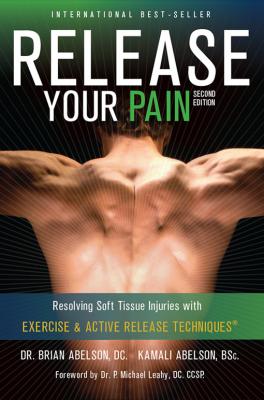ТОП просматриваемых книг сайта:
Release Your Pain: 2nd Edition - EBOOK. Dr. Brian James Abelson DC.
Читать онлайн.Название Release Your Pain: 2nd Edition - EBOOK
Год выпуска 0
isbn 9780987866219
Автор произведения Dr. Brian James Abelson DC.
Жанр Здоровье
Серия Release Your Body
Издательство Ingram
Think of your neck as a mast on a sailboat, surrounded by the rigging lines which control and stabilize the mast. These rigging lines are made up of the muscles and work remarkably well as long as you maintain a fine balance of strength and flexibility in these structures.
There are many muscles in your neck and jaw and it is far beyond the scope of this book to provide a detailed description of each of these structures. I will try to limit my discussion to those structures that I believe to be the most common causes of jaw and neck pain. I will first cover some of the important jaw and neck muscles on the anterior or lateral sides of the neck. I will then discuss the various layers (superficial, intermediate, and deep) of the posterior neck and back muscles. I am reviewing the posterior muscles of the neck and back in this manner because many of these muscles can extend all the way from the bottom of your spine (lumbar region) right up into the base of your skull, creating a very long kinetic chain.
The Importance of Fascia
Every muscle in your body is infused with, surrounded by, and connected to adjacent muscles and bone by a fibrous connective tissue known as fascia. Fascia is a key factor that we must include if we are to develop a real understanding of our body’s kinetic chains.
Muscle fibres originate from, and insert into, fascial fibres. In turn, these fascial fibres insert into multiple regions of both bone and adjacent muscles. These additional points of contact and control give your muscles the ability to generate force in multiple directions. Thus, even though we speak about specific muscles and their actions, it is important to remember that the deeply interconnecting fasciae form one of the primary, interconnecting elements of our body’s kinetic web.
Each muscle works together as part of a functional unit, in which their actions coordinate across multiple joints. Depending on the degree of motion and amount of force required, contractions only occur within very specific areas of each muscle, not across the entire muscle. These very specific motions are largely coordinated, not by the brain, but by the neurological receptors embedded in the fascia.
Kinetic Chain Structures of the Jaw
There are many structures that play an important role in the kinetic chain relationships of the muscles of the jaw.
Fig 6.2: Anterior muscles of the neck and shoulder.
The following muscles are commonly affected by neck and shoulder tension.
Masseter muscle - This thick quadrilateral muscle works to close and retract the jaw (mandible) and to chew food (muscle of mastication). Restrictions or trigger points in this muscle can be related to TMJ problems, headaches, sinus pain or even toothaches.
Temporalis muscle - This muscle of mastication is used to close the jaw and chew your food. Restrictions in this structure are a common cause of tension headaches.
Medial pterygoid muscle - Also known as the internal pterygoid. This muscle is involved in closing the jaw (elevation of mandible), and in the protrusion of the jaw (mandible). Restrictions in the medial pterygoid are often related to TMJ problems.
Digastric muscle - This small superficial muscle depresses the lower jaw and raises the hyoid bone during swallowing. This muscle is needed to fully open your mouth. A trigger point in this muscle often develops if a person is experiencing any jaw problems.
Anterior and Lateral Muscles of the Neck
Fig 6.3: Sternocleidomastoid muscle of the
Sternocleidomastoid - This large superficial muscle is connected to the sternum, clavicle, and skull. It acts to elevate (or lift) the sternum and collar bone and participates in the lateral flexion, extension, and rotation of the neck. Restrictions in this muscle often refers pain to the jaw, head and sternum. Problems with this muscle are often related to headaches and even balance issues.
Rectus Capitis Lateral and Anterior - Works to laterally flex the head.
Longus Capitis - Works to straighten the upper neck and participates in forward and lateral flexion of the neck.
Longus Colli - This deep muscle flexes the neck, straightens the spine, and assists in lateral flexion of the head. Restrictions in this muscle can cause difficulty in swallowing and affect speech. This muscle is often injured during whiplash injuries.
Scalenes - This superficial layer of muscles extends through the front, centre, and back of the neck. They function in lateral flexion and rotation, and work to elevate the first three ribs during inhalation, allowing the lungs to expand. This muscle is commonly involved in several nerve entrapment syndromes including Carpal Tunnel Syndrome. In fact, restrictions in the scalenes are often the cause of upper back, chest, shoulder, arm, wrist, or even hand pain.
Fig 6.4: Scalene muscles of the neck.
The longus colli, scalenes, and longus capitis all work together to stabilize the cervical spine. and are frequently injured during whiplash accidents.
Neurological Impact of the Neck’s Kinetic Chain
Whenever an injury occurs in the neck (such as a sprain/strain), it damages not only the ligaments, tendons, and muscle fibres, but also their embedded neurological structures (Golgi tendon organs, muscle spindles, and joint receptors). These neurological structures play an essential role in postural control. Any damage to these structures can affect overall spinal stability, and lead to chronic back problems.
Конец ознакомительного фрагмента.
Текст предоставлен ООО «ЛитРес».
Прочитайте эту книгу целиком, купив полную легальную версию на ЛитРес.
Безопасно оплатить книгу можно банковской картой Visa, MasterCard, Maestro, со счета мобильного телефона, с платежного терминала, в салоне МТС или Связной, через PayPal, WebMoney, Яндекс.Деньги, QIWI Кошелек, бонусными картами или другим удобным Вам способом.

